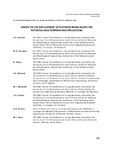| dc.contributor.author | Papo, M J | |
| dc.contributor.author | Rading, G O | |
| dc.contributor.author | Cornish, L A | |
| dc.contributor.author | Shongwe, M B | |
| dc.contributor.author | Shown, L H | |
| dc.contributor.author | Witcomb, M J | |
| dc.contributor.author | Odusote, J K | |
| dc.contributor.author | Odera, B | |
| dc.date.accessioned | 2013-06-27T10:34:33Z | |
| dc.date.available | 2013-06-27T10:34:33Z | |
| dc.date.issued | 2012 | |
| dc.identifier.citation | Rading, GO. 2012. L A Cornish, M B Shongwe, B Odera, J K Odusote, M J Witcomb, L H Shown, G O Rading and M J Papo: Update on the Development of Platinum Based Alloys for Potential High Temperature Applications. Platinum 2012. , Johannesburg: The Southern African Institute of Mining and Metallurgy | en |
| dc.identifier.uri | http://scholar.google.com/scholar?q=Update+On+The+Development+Of+Platinum+Based+Alloys+For+Potential+High+Temperature+Applications&btnG=&hl=en&as_sdt=0%2C5 | |
| dc.identifier.uri | http://erepository.uonbi.ac.ke:8080/xmlui/handle/123456789/41038 | |
| dc.description.abstract | Pt-based alloys for high-temperature applications in aggressive environments have been under
development for over 10 years, and are targeted to be used as either as bulk, or as coatings.
The alloys comprise Pt, Al, Cr, and Ru, and the microstructure has been improved by
composition to a best possible analogue of the nickel-based superalloys, which these alloys
could partially replace. This was necessary because the previous best alloy had a strengthening
precipitate volume proportion of only approximately 40 vol.%, whereas the nickel-based
superalloys have around 70 per cent, and a lower volume would mean that the strength would
not be the best that could be obtained. The microstructures were assessed using electron
microscopy, and have been related to the alloys’ hardness values. The current microstructures
are much more like those of NBSAs, with a high proportion of the strengthening ~Pt3Al
precipitates. Since the samples have to be small (platinum is expensive), hardness has been
used as an indication of strength. Nano-indentation studies showed that the hardness and
Young’s modulus were higher for ~Pt3Al than the (Pt) matrix.
More extensive oxidation studies have been undertaken on the previous optimum sample, and
the effect of cooling rate after heat treatment has also been ascertained. In addition, the
samples were studied after different heat treatment times, and cross-sections were made in
order to characterize the alumina scale that formed. The oxide scales of Pt-11Al-3Cr-2Ru (at.%)
up to 100 h exposure did not spall, and were at least as good as those of the ternary alloys.
There was no discernable Al depletion zone in the substrate, although it could have been at a
greater depth than thickness of the samples studied.
Further additions to the Pt-Al-Cr-Ru alloys have been studied, to increase the melting
temperature as well as to reduce the platinum content without compromising the properties.
Reduced platinum content would have the benefits of reduced density and cost. The target
elements include vanadium and niobium, of which vanadium is of special interest, since it is a
South African product. Before these additions could be made, phase equilibria studies were
undertaken so that the maximum addition could be ascertained, and also to check any possible
ternary phases, which could be deleterious. Work on the Pt-Al-V system revealed a ternary
phase, ~V27Pt54Al19 (at.%), which has a eutectic reaction with (Pt). The maximum V addition is
likely to be around 15 at.%, otherwise ~Pt3V or the ternary phase will form, and not the
required (Pt)/~Pt3Al phases. | en |
| dc.language.iso | en | en |
| dc.title | Update On The Development Of Platinum Based Alloys For Potential High Temperature Applications | en |
| dc.type | Article | en |
| local.publisher | Mechanical and Manufacturing Engineering, University of Nairobi | en |
| local.publisher | School of Chemical and Metallurgical Engineering, University of the Witwatersrand, South Africa | en |
| local.publisher | Faculty of Engineering and Technology, Department of Mechanical Engineering, University of Ilorin, Ilorin, Nigeria | en |
| local.publisher | African Materials Science and Engineering Network (AMSEN): A Carnegie-IAS Network | en |

